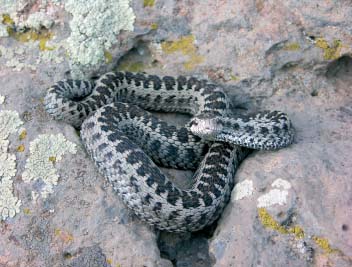Darevsky's viper: Red Data Book of Armenia

Vipers and Pitvipers — Viperidae
Status. A species of very limited distribution. Listed in the IUCN Red List of Threatened Species (ver. 3.1) as Critically Endangered CR B1ab(ii,iii)+2ab(ii,iii). According to IUCN criteria categorized as Critically Endangered CR B2ab (ii, iii).
Distribution. The range extends over the south–western slopes of the Javakhq Ridge in Armenia northwards to the border with Georgia (Mt. Achkasar), at 2350–3000 m above sea level.
Distribution in Armenia. Ashotsk district, Shirak Province. In 2008, the entire range covered 200 ha.
Habitats. Stony slopes, rocky outcrops and screes with flat stone slabs located in subalpine meadows.
Biological traits. Active from early May to late September. Feeds on invertebrates and lizards. Mating begins in mid–May. Ovoviviparous. The offspring (5–8) are born in mid–September and start moulting immediately after the birth. Late reproduction in highland conditions allows to surmise that the newborn go to hibernation after the birth and begin feeding only in the next year’s spring.
Population size and its trends. The population density in typical habitats is quite high, ca. 10–12 individuals/ha.
Major threats. Destruction of suitable habitats, intensive use of highland meadows, uncontrolled overgrazing and poaching.
Conservation measures. Protected in Lake Arpi National Park. In 2004, within the programme "Measures for conservation of the Darevsky’s viper in the Caucasus" a set of urgent conservation activites was developed towards the isolation of viper habitats from human pressure and their preservation. It is essential to delineate and fence off the viper habitats, incorporate them to the reserve zone of Lake Arpi National Park and to strengthen control over illegal harvesting of this species.
Suggestions
 The Ministry of Environment sent a letter international partners to draw their attention to the real danger of environmental disasters as a result of Azerbaijan's large-scale aggression towards the territory of Armenia
The Ministry of Environment sent a letter international partners to draw their attention to the real danger of environmental disasters as a result of Azerbaijan's large-scale aggression towards the territory of Armenia
 Vicia pisiformis: Red Data Book of Armenia
Vicia pisiformis: Red Data Book of Armenia
 Vavilovia formosa: Red Data Book of Armenia
Vavilovia formosa: Red Data Book of Armenia
 Trigonella capitata: Red Data Book of Armenia
Trigonella capitata: Red Data Book of Armenia
 Trigonella astroides: Red Data Book of Armenia
Trigonella astroides: Red Data Book of Armenia












